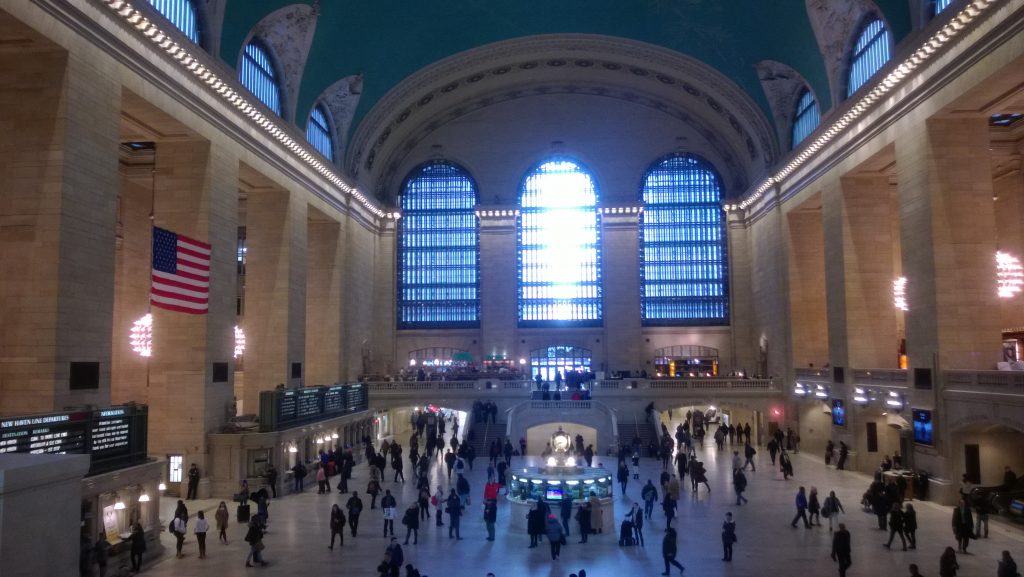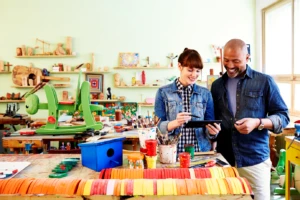So what is the 2016 Retail Trend Forecast anyway?
Where should you go to look for trends? Everywhere. Port cities happen to be an excellent place, said Marian Salzman in her presentation, because a lot of people are coming and going. Photo: Grand Central Station, New York City, January 2016, Esther Christoffersen.
It was another bustling Big Show hosted by the National Retail Federation in New York this January, and one of the most anticipated sessions was Marian Salzman’s keynote Future of Everything: Top Trends Key to Anticipating What’s Next for 2016 and Beyond. Every year or so, Marian presents her trend forecast and I think she must have one of the most interesting jobs in the world. She shared with the audience the back-drop for trend-spotting with such conviction that I wondered if she has a crystal ball to peer into. But it’s not that simple. Tracking trends relies on a process that is technical, data driven and continuous. No stone goes unturned, she explained.
The context for her observations is both deep and wide, micro and macro, and includes social, cultural, and economic trends. She looks across industries, she looks at business, at oil and gas, at the environment, world dynamics and economy, political unrest, and cultural moments in time among many other factors.
“A trend spotter never sleeps,” Salzman explained, “because he or she is dreaming of trends.”
“A trend spotter never sleeps,” she explained, “because he or she is dreaming of trends.” And with that, she started to roll out her forecast for 2016, one trend at a time, while we sat quiet and captivated in that dark keynote hall, curious and wondering what trend would be revealed next. Would it be something obvious? Or a shocker? The trend forecast is included below and I’ve also linked to her presentation at the end of this post.
1. The Ubertrend for 2016 is “Uneasy Street”
There is a lot of fear and unease out there today. “Do we stay in or bail out?” seems to be the tagline for everyone’s constant struggle. People are seeking easy and enjoyable ways to make the present and future more secure. In this world where most customers are anxious, overwhelmed, overloaded – what can YOU (the retailer) do to help them feel more at ease?
2. Tech addict, control thyself
Technology is harming our ability to be together and pay attention to one another. We are in an ‘always on’ 24/7 connected environment. We will see cyber self-control programs become as common as diets and exercise plans, Marian predicted. For retailers: you’re familiar with show-rooming, and when consumers do get to your stores, many are only “halfway” there (thanks to the mobile phone). What can you do to emotionally engage them? Human interactions must successfully interrupt their parallel digital lives.
3. Golden age of BS
Today, truth matters less and less. Most people are satisfied with “truthiness” (what they want the facts to be). This means brands and well-known people will find more mileage in making big, bold claims that don’t necessarily stick to the facts. For the retailer: are your communications with consumers SHOUTING? Deceptive? Evaluate your B.S.-ometer score, said Marian.
4. What’s renewable will be new again
Most people still aren’t worried about climate change. Instead, the next trend includes new areas of tech lust – personal power-generation technologies, anyone? Retailers: pay attention because clean energy gadgets are on the rise – think IT, domestic appliances, gardening, outdoor, even apparel.
5. Mind the App
Today’s millions of apps are just the beginning of a self-reinforcing loop of application. “Life is going to be appified,” said Marian. It’s getting so easy, that non-techie DIYers will invent apps in a massive wave of crowdsourced problem solving. While building a dedicated app might not suit all retailers, if you do, make it useful and relevant for customers. At the very least, optimize your website for mobile users.
6. Getting smart
Today the world is going crazy not just for smart people but for smart everything. You should expect any item with a chip built into it to get described as “smart”. For retailers, how are you making “smart” part of your brand? Integrating mobile compatible smart technology into product labels and tags? This will give customers useful info and is an opportunity to plug promotions.
7. Roar of the cloud
Today, we can do more and more in the cloud with other people: we can collaborate, raise funds, share ideas, study, tackle problems. (Incidentally, she mentioned, in an effort to help some of the world’s biggest problems, Microsoft has announced plans to donate $1bn of its cloud services to non-profits and University research departments). I think we can agree that the cloud is crucially important. What this means though, is that more and more, people will find little to no value for many activities requiring physical presence, so they just won’t bother. Big retailers pioneered using internet to reduce costs and increase reach. The cloud lets small retailers do the same. The challenge will be finding the best mix of cloud and physical presence.
8. Livin’ large no more
Many agree, the world’s greatest cities are costly and crowded. What once were thought of as second and third tier cities, such as Boston and Portland, are becoming the magnets for many people who want an increase in quality of life. What does this mean for retail? At the heart of modern life is buying and selling. Retail can help shape the new dynamic cities and neighborhoods.
9. Experience is the new classroom
Today, practical, hands-on skills are becoming less common and more valued. “We’d rather have less and do more, Marian explained, and “smart, by the way,” she continues, “is the sexiest currency there is.” Robust experiential education must be key to organizations’ new business models. You will lose employees (especially millennials) if they think you just want to give them a pay check. Everyone has experience as a retail customer and an employee. This close relationship puts retailers in an ideal position: the best will increase their community’s skills base and prosperity, creating a virtuous circle with major brand benefits.
10. Cooking, R.I.P.
Do you cook? Maybe? Sometimes? I love to, but I also know that it’s time consuming and more of a “weekend luxury” for me personally. Marian explained that preparing meals from fresh ingredients is becoming old-fashioned and unnecessary. At every level, Marian continued, the market for easy-cook and no-cook ingredients will keep rising. It was the retail industry that helped bring precooked ingredients to tables. The next focus will be on nutritional quality. But the more that consumers rely on prepared meals, the more that the retail industry will become implicated in health issues.
One other thing Marian mentioned was a shift and growing trend towards sharing. Think Uber. Zipcar. Lyft. Study them. What does this mean for car companies? People don’t necessarily want to own everything. The future will include pet sharing, Marian explained. Yes. Collaborative ownership of pets! Can you imagine having a “share dog”? (Pet stores take note, there might be opportunity here.)
It was a fabulous session and let’s see what kind of year 2016 is! “The future is not just something that happens,” Marian concluded, “we co-create it.”
You can download the PDF presentation from the NRF website.

